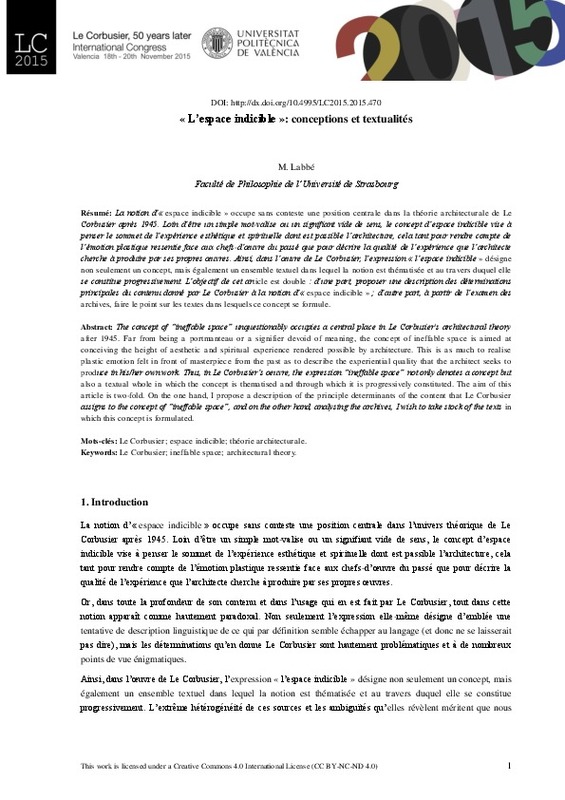JavaScript is disabled for your browser. Some features of this site may not work without it.
Buscar en RiuNet
Listar
Mi cuenta
Estadísticas
Ayuda RiuNet
Admin. UPV
« L’espace indicible »: conceptions et textualités
Mostrar el registro sencillo del ítem
Ficheros en el ítem
| dc.contributor.author | Labbé, Mickaël
|
es_ES |
| dc.date.accessioned | 2017-09-08T09:03:44Z | |
| dc.date.available | 2017-09-08T09:03:44Z | |
| dc.date.issued | 2016-03-03 | |
| dc.identifier.isbn | 9788490483732 | |
| dc.identifier.uri | http://hdl.handle.net/10251/86798 | |
| dc.description.abstract | [EN] The concept of “ineffable space” unquestionably occupies a central place in Le Corbusier's architectural theory after 1945. Far from being a portmanteau or a signifier devoid of meaning, the concept of ineffable space is aimed at conceiving the height of aesthetic and spiritual experience rendered possible by architecture. This is as much to realise plastic emotion felt in front of masterpiece from the past as to describe the experiential quality that the architect seeks to produce in his/her own work. Thus, in Le Corbusier’s oeuvre, the expression “ineffable space” not only denotes a concept but also a textual whole in which the concept is thematised and through which it is progressively constituted. The aim of this article is two-fold. On the one hand, I propose a description of the principle determinants of the content that Le Corbusier assigns to the concept of “ineffable space”, and on the other hand, analysing the archives, I wish to take stock of the texts in which this concept is formulated. | es_ES |
| dc.description.abstract | [FR] : La notion d’« espace indicible » occupe sans conteste une position centrale dans la théorie architecturale de Le Corbusier après 1945. Loin d’être un simple mot-valise ou un signifiant vide de sens, le concept d’espace indicible vise à penser le sommet de l’expérience esthétique et spirituelle dont est passible l’architecture, cela tant pour rendre compte de l’émotion plastique ressentie face aux chefs-d’œuvre du passé que pour décrire la qualité de l’expérience que l’architecte cherche à produire par ses propres œuvres. Ainsi, dans l’œuvre de Le Corbusier, l’expression « l’espace indicible » désigne non seulement un concept, mais également un ensemble textuel dans lequel la notion est thématisée et au travers duquel elle se constitue progressivement. L’objectif de cet article est double : d’une part, proposer une description des déterminations principales du contenu donné par Le Corbusier à la notion d’« espace indicible » ; d’autre part, à partir de l’examen des archives, faire le point sur les textes dans lesquels ce concept se formule. | es_ES |
| dc.language | Francés | es_ES |
| dc.publisher | Editorial Universitat Politècnica de València | es_ES |
| dc.relation.ispartof | LE CORBUSIER. 50 AÑOS DESPUÉS | es_ES |
| dc.rights | Reconocimiento - No comercial - Sin obra derivada (by-nc-nd) | es_ES |
| dc.subject | architecture | es_ES |
| dc.subject | le corbusier | es_ES |
| dc.subject | modern movement | es_ES |
| dc.title | « L’espace indicible »: conceptions et textualités | es_ES |
| dc.type | Capítulo de libro | es_ES |
| dc.type | Comunicación en congreso | es_ES |
| dc.identifier.doi | 10.4995/LC2015.2015.470 | |
| dc.rights.accessRights | Abierto | es_ES |
| dc.description.bibliographicCitation | Labbé, M. (2016). « L’espace indicible »: conceptions et textualités. En LE CORBUSIER. 50 AÑOS DESPUÉS. Editorial Universitat Politècnica de València. 1093-1107. https://doi.org/10.4995/LC2015.2015.470 | es_ES |
| dc.description.accrualMethod | OCS | es_ES |
| dc.relation.conferencename | LC2015 - Le Corbusier, 50 years later | es_ES |
| dc.relation.conferencedate | November 18-20,2015 | es_ES |
| dc.relation.conferenceplace | Valencia, Spain | es_ES |
| dc.relation.publisherversion | http://ocs.editorial.upv.es/index.php/LC2015/LC2015/paper/view/470 | es_ES |
| dc.description.upvformatpinicio | 1093 | es_ES |
| dc.description.upvformatpfin | 1107 | es_ES |
| dc.type.version | info:eu-repo/semantics/publishedVersion | es_ES |
| dc.relation.pasarela | OCS\470 | es_ES |








